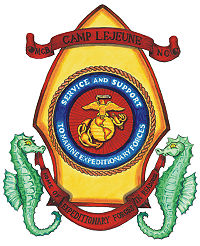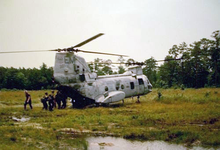- Marine Corps Base Camp Lejeune
-
Marine Corps Base Camp Lejeune Onslow County, near Jacksonville, North Carolina 34°35'34.08"N 77°20'32.60"W

MCB Camp Lejeune InsigniaType Military base Built 1941 In use 1941–present Controlled by USMC Garrison II Marine Expeditionary Force
Marine Special Operations CommandMarine Corps Base Camp Lejeune (pronounced /ləˈdʒuːn/ lə-june[1] or /ləˈdʒɜrn/ lə-jurn[2]) is a 246-square-mile (640 km2)[3] United States military training facility in North Carolina. The base's 14 miles (23 km) of beaches make it a major area for amphibious assault training, and its location between two deep-water ports (Wilmington and Morehead City) allows for fast deployments.
The main base is supplemented by five satellite facilities: Marine Corps Air Station New River, Camp Geiger, Stone Bay, Courthouse Bay, Camp Johnson, and the latest addition to the facility, the Greater Sandy Run Training Area.
Contents
Resident commands
- II Marine Expeditionary Force
- Marine Corps Forces Special Operations Command
- 2nd Marine Division
- 2nd Marine Logistics Group
- 2nd Marine Expeditionary Brigade
- 22nd Marine Expeditionary Unit
- 24th Marine Expeditionary Unit
- 26th Marine Expeditionary Unit
- 2nd Reconnaissance Battalion,
- Marine Corps Installations East
- Marine Corps Engineer School
- United States Marine Corps School of Infantry
- Marine Corps Combat Service Support Schools
- Reserve Support Unit
- Naval Hospital Camp Lejeune
- Field Medical Training Battalion (FMTB)
- Joint Maritime Training Center (USCG)
- Marine Special Operations Regimen
- Marine Special Operations Support Group
History
In April 1941, construction was approved on an 11,000-acre (45 km2) tract in Onslow County, North Carolina. On May 1 of that year, Lt. Col. William P. T. Hill began construction on Marine Barracks New River. The first base headquarters was in a summer cottage on Montford Point, and then moved to Hadnot Point in 1942. Later that year it was renamed in honor of the 13th Commandant of the Marine Corps, John A. Lejeune.
One of the satellite facilities of Camp Lejeune served for a while as a third boot camp for the Marines, in addition to Parris Island and San Diego. That facility, Montford Point, was established after Franklin D. Roosevelt signed Executive Order 8802. Between 1942 and 1949, a brief era of segregated training for black Marines, the camp at Montford Point trained 20,000 African-Americans.[citation needed] After the military was ordered to fully integrate, Montford Point was renamed Camp Gilbert H. Johnson and became the home of the Marine Corps Combat Service Support Schools.
 American Indian Women Reservists at Camp Lejeune during 1943
American Indian Women Reservists at Camp Lejeune during 1943
MCB Camp Lejeune, can help to prepare warfighters for combat and humanitarian missions abroad, Camp Lejeune takes advantage of 156,000 acres, 11 miles of beach capable of supporting amphibious operations, 32 gun positions, 48 tactical landing zones, three state-of-the-art training facilities for Military Operations in Urban Terrain and 80 live fire ranges to include the Greater Sandy Run Training Area. Military forces from around the world come to Camp Lejeune on a regular basis for bilateral and NATO-sponsored exercises.
Pollution
For more details on this topic, see Camp Lejeune water contamination.From at least 1957 through 1987, Marines and their families at Lejeune drank and bathed in water contaminated with toxins at concentrations 240 to 3400 times permitted by safety standards, and at least 850 former residents filed claims for nearly $4 billion from the military. The main chemicals involved were trichloroethylene (TCE), a degreaser, perchloroethylene (PCE), a dry cleaning solvent, and benzene; however, more than 70 chemicals have been identified as contaminants at Lejeune.[4]
A 1974 base order required safe disposal of solvents and warned that improper handling could cause drinking water contamination. Yet solvents were dumped or buried near base wells for years.[5]
The base's wells were shut off in the mid-1980s, but were placed back online in violation of the law.[4] In 1982, Volatile organic compounds (VOCs) were found to be in Camp Lejeune's drinking water supply.[6] VOC contamination of groundwater can cause birth defects and other ill health effects in pregnant and nursing mothers. This information was not made public for nearly two decades when the government attempted to identify those who may have been exposed.
An advocacy group called The Few, The Proud, The Forgotten was created to inform possible victims of the contamination at Lejeune. The group's website includes an introduction with some basic information about the contamination at Lejeune, including that many health problems various types of cancer, leukemia, miscarriages and birth defects, have been noted in people who drank the contaminated water. According to the site, numerous base housing areas were affected by the contamination, including Tarawa Terrace, Midway Park, Berkeley Manor, Paradise Point, Hadnot Point, Hospital Point, and Watkins Village.[7]
On March 8, 2010, Paul Buckley of Hanover, Massachusetts, received a 100%, service connected disability from the Department of Veterans Affairs for cancer (Multiple Myeloma), which was linked to toxic water exposure on Camp Lejeune. This is believed to be the first time the government has admitted the link between the contamination and illnesses.[8]
In 2007, Jerry Ensminger, a retired Marine master sergeant, found a document dated 1981 that described a radioactive dump site near a rifle range at the camp. According to the report, the waste was laced with strontium-90, an isotope known to cause cancer and leukemia.[4] According to Camp Lejeune's installation restoration program manager, base officials learned in 2004 about the 1981 document.[4] Ensminger served in the Marine Corps for 24 and a half years, and lived for part of that time at Camp Lejeune. In 1985 his 9-year-old daughter, Janey, died of cancer.[4]
On July 6, 2009, Laura Jones filed suit against the US government over the contaminated water at the base. Jones previously lived at the base where her husband, a Marine, was stationed. Jones has lymphoma and now lives in Iowa.[9]
Twenty former residents of Camp Lejeune—all men who lived there during the 1960s and the 1980s—have been diagnosed with breast cancer. Due to the relatively low rate of male breast cancer in the United States, pollution at Camp Lejeune is presumed to be a major contributor to these illnesses.[10]
In April 2009, the United States Agency for Toxic Substances and Disease Registry withdrew a 1997 public health assessment at Camp Lejeune that denied any connection between the toxins and illness.[11]
As many as 500,000 people may have been exposed to contaminated water at Camp Lejeune over a period of 30 years. Although no official studies have definitively connected the contamination with illness, former residents of Camp Lejeune suffer from a high rate of cancer and other diseases. Children from the Marines have also shown signs of brain cancer and leukemia.[10]
Marine Corps Brig
The military prison at Camp Lejeune has been in operation since 1968 and currently has a maximum capacity of 280 inmates who are incarcerated between 30 and 90 days.
The Base Realignment and Closure Commission (BRAC) recommended in 2005 that the brig be closed and the Secretary of Defense has to implement the commission's recommendations by a date still unknown. A new brig was built at Camp Allen in Norfolk, Virginia with a small detention facility built at Camp Lejeune to hold detainees awaiting court martial.
See also
- Museum of the Marine
- Camp Lejeune Incident
- Marine Corps Air Station New River
- List of United States Marine Corps installations
- Lejeune High School, located on base, serving military dependents
- Murder of Maria Lauterbach, a Lance Corporal stationed at Camp Lejeune who was murdered in December 2007.
References
- This article incorporates text in the public domain from the United States Marine Corps.
- ^ Pronouncing The 'R' In Camp Lejeune "One of the Marine Corps' biggest bases is Camp Lejeune (luh-JUNE) in North Carolina. But for years, many people have been mispronouncing the base's name. The family of Lt. Gen. John Lejeune, whom the base was named for, says luh-JERN. Now there's quiet move in the military to correct the pronunciation."
- ^ Lejeune, Lejern, and How to Say It - Leatherneck Magazine
- ^ "Camp Lejeune History". United States. http://www.lejeune.usmc.mil/mcb/history.asp. Retrieved 2007-10-01.
- ^ a b c d e Thompson, Estes (2007-07-10). "EPA investigating whether radioactive waste was buried at pollution-plagued Camp Lejeune". ABC News, Associated Press. http://abcnews.go.com/print?id=3364429. Retrieved 2007-09-29.
- ^ Camp Lejeune residents blame rare cancer cluster on the water For three decades, dry-cleaning chemicals and industrial solvents laced the water used by local Marines and their families. Mike Partain and at least 19 others developed male breast cancer.
- ^ Coverage of what happened at Camp Lejeune
- ^ The Few, The Proud, The Forgotten. 2008-02-04. Access date 2008-02-06
- ^ Sawyer, Diane, and Steve Osunsami, "Toxic Water", ABC World News, March 19, 2010.
- ^ Contaminated Water At Base Spurs Suit July 7, 2009
- ^ a b Male breast cancer patients blame water at Marine base
- ^ ATSDR Withdraws Scientifically Flawed Public Health Document
External links
- [1]
- Video summary of findings at Camp Lejeune Study
- The Few, The Proud, The Forgotten
- Camp Lejeune Vets/Personnel - search through Camp Lejeune vets and personnel at GIsearch
- Camp Lejeune official website, including a history of Camp Lejeune
- Camp Lejeune Globe, military-authorized newspaper
- Montford Point Marines Honored at DoD Observance, a February 2006 AFIS press release
- Onslow Beach - an introduction - article with image gallery of military training exercises, at Citizendium
- Agency for Toxic Substances and Disease Registry - Camp Lejeune, North Carolina: Water Modeling
- An inside look at the base brig at www.lejeune.usmc.mil
- USMC Camp Lejeune Base Overview & PCS Information (MarineCorpsUSA.org)
- How to pronounce Lejeune
Current military installations of North CarolinaArmy  FortPortAir FieldMackall • SimmonsRange
FortPortAir FieldMackall • SimmonsRange
Marines  Air StationCampRangeLanding Field
Air StationCampRangeLanding FieldNavy  RangeBrant Island • Dare County • Piney Island • Stumpy Point
RangeBrant Island • Dare County • Piney Island • Stumpy PointAir Force  OtherAir Force Combat Climatology Center
OtherAir Force Combat Climatology CenterCoast Guard  Cape Hatteras • Fort MaconStationElizabeth City • Emerald Isle • Fort Macon • Hattaras Inlet • Hobucken • Oak Island • Ocracoke • Oregon Inlet • Wrightville BeachSupport CenterElizabeth City
Cape Hatteras • Fort MaconStationElizabeth City • Emerald Isle • Fort Macon • Hattaras Inlet • Hobucken • Oak Island • Ocracoke • Oregon Inlet • Wrightville BeachSupport CenterElizabeth CityMunicipalities and communities of Onslow County, North Carolina City Towns CDPs Unincorporated
communitiesHubert | Montclair | Petersburg
Military bases Camp Lejeune | New River Air Station
Footnotes ‡This populated place also has portions in an adjacent county or counties
Coordinates: 34°35′34.08″N 77°20′32.6″W / 34.5928°N 77.342389°W
Categories:- Military facilities in North Carolina
- Populated places in Onslow County, North Carolina
- United States Marine Corps bases
- World War II sites
- Military Superfund sites
Wikimedia Foundation. 2010.




